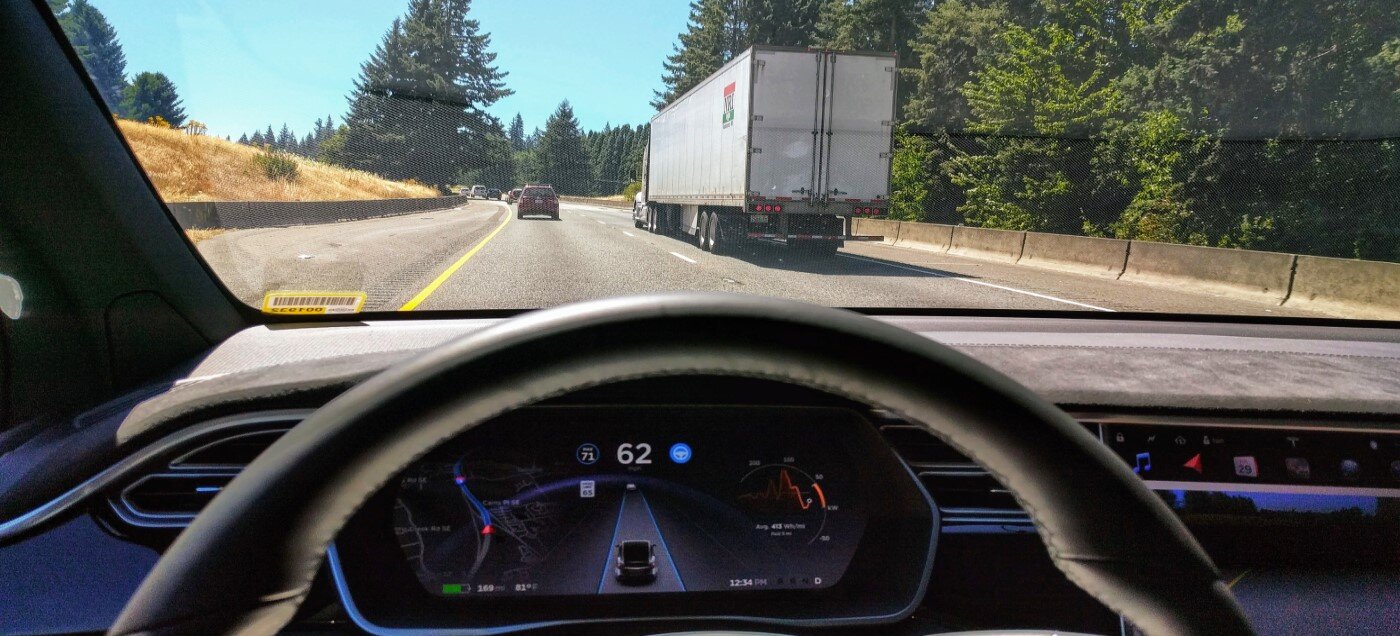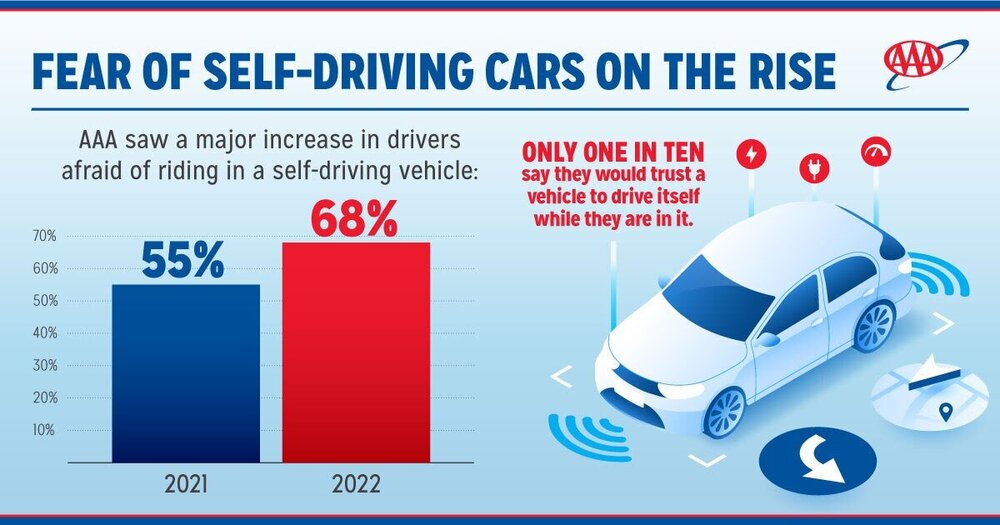Residential Real Estate News

Fear of Self-Driving Cars on the Rise as Vacation Season Nears
Residential News » Atlanta Edition | By David Barley | March 3, 2023 9:01 AM ET
According to an annual automated vehicle survey just released by AAA, concerns about self-driving cars are significantly higher than last year. The survey reveals 68% of drivers are afraid of riding in a self-driving vehicle. That's up from 55% in 2022, and the largest annual increase since 2020.
"We did not expect such a dramatic shift in consumer concerns from previous years," said Mark Jenkins, Public Relations Manager for AAA - The Auto Club Group. "Though it isn't entirely surprising, given the number of high-profile crashes that have recently occurred from over-reliance on current vehicle technologies."
Dispelling Confusion Around Automated Vehicles
Even with advancements made in recent years, these findings suggest the need to dispel confusion around automated vehicles. AAA's survey found that nearly one in ten drivers believe they can buy a vehicle that drives itself while they sleep. That is not true.
While this perception could stem from social media videos of drivers apparently misusing driver assistance technology, our survey shows that the names manufacturers have given their vehicle systems are confusing consumers. AAA found that 22% of Americans expect driver support systems, with names like Autopilot, ProPILOT, or Pilot Assist, to have the ability to drive the car by itself without any supervision, indicating a gap in consumer understanding.
"Most new vehicles are equipped with some level of advanced driver assistance technology, which can enhance the safety of motorists if used properly," Jenkins continued. "However, it's important to clarify that there are currently no vehicles available for purchase that allow someone to fully disengage from the task of driving."
What are Advanced Driver Assistance Systems (ADAS)?
Consumers are not entirely opposed to advanced vehicle technology. In fact, six in ten U.S. drivers would "definitely" or "probably" want these systems in their next car purchase.
- Examples of ADAS include blind spot warning, adaptive cruise control and automatic emergency braking. Check out AAA's, Clearing the Confusion, which provides naming and descriptions of ADAS in a consistent, easy-to-understand manner.
- Active driving assistance (ADA) combines the tasks of braking, accelerating, and steering through a combined use of adaptive cruise control and lane keeping assistance. ADA is classified as Level 2 automation - the highest level of vehicle automation available for purchase by the public. This technology is not meant to replace the driver. Recent AAA research has found inconsistencies with ADA performance, reinforcing the need for a driver to remain fully engaged.
What is a fully self-driving vehicle?
A vehicle capable of operating without human involvement. A human driver is not required to control the vehicle at any time, nor required to be present in the vehicle while moving. These vehicles are not available for purchase by consumers and are classified as Level 5 automation as defined by the Society of Automotive Engineers.
Sign Up Free | The WPJ Weekly Newsletter
Relevant real estate news.
Actionable market intelligence.
Right to your inbox every week.
Real Estate Listings Showcase
Related News Stories
Residential Real Estate Headlines
- Las Vegas Area Home Prices Uptick 4.3 Percent Annually in March
- Single-Family Rent Growth in U.S. Trends Upward in 2025
- U.S. Mortgage Rates Tick Down Post Trump Tariffs Commencement
- President Trump's 'Liberation Day' Tariffs Potential Impact on the U.S. Housing and Mortgage Markets
- Baby Boomers Biggest Cohort of U.S. Home Buyers in 2025 as Millennials Decline
- U.S. Monthly Housing Payments Hit Record High in 2025
- U.S. Pending Home Sales Uptick in February
- Global Prime Residential Rent Slowdown Continued in Late 2024
- Ireland Home Price Inflation Hits 8 Year High in Early 2025
- Existing Home Sales in America Uptick in February
- Great Miami Area Residential Sales Decline 15 Percent Annually in February
- Mortgage Rates Uptick in Mid-March, Ending 9-Week Decline in U.S.
- World Property Ventures Builds the Future of Real Estate with New Funding Round
- U.S. Builder Sentiment Declines Amid Economic Uncertainty and Rising Costs
- Black Homeownership Rates in U.S. Enjoy Largest Annual Increase of All Racial Groups
- Wealthy Renters Are Taking Over More of the U.S. Rental Market
- If U.S. Congress Does Not Extend NFIP Soon, Thousands of Daily Home Closings Impacted
- U.S. Mortgage Applications Spike 11 Percent in Early March
- Greater Palm Beach Area Residential Sales Rise in Early 2025
- New Apartments in U.S. Are Leasing at Slowest Pace on Record
- U.S. Mortgage Rates Drop to 4 Month Low in March
- Overall U.S. Mortgage Delinquency Rates Dip in December
- New Tariffs on Canada, Mexico to Impact U.S. Homebuilder Input Costs
- Monaco's Property Market: A Tale of Two Cities
- U.S. Home Purchase Cancellations Surge, 1 in 7 Sales Getting Canceled
- U.S. Pending Home Sales Hit Historic Low in Early 2025
- Greater Miami Area Residential Sales Dip in January
- Governor DeSantis Supports Ending Property Taxes in Florida
- WPV Aims to Become the Berkshire Hathaway of Real Estate Tech
- U.S. Home Sales Slump Continues in January
- Average Americans Spend 38 Percent of Monthly Income on Mortgage Payments
- Switzerland's Safe-Haven Appeal Grows with World's Wealthy Homebuyers
- U.S. Builder Confidence Rapidly Declines in February
- Las Vegas Home Sales Rise 6.7 Percent Annually in January, Condo Sales Dip
- Homebuyer Demand in America Drops to 5-Year Low in Early 2025
- Ownership More Affordable Than Renting in Most U.S. Markets
- The World's First Global Listings Service Launches, Called a GLS
- Home Prices Continue to Rise in 89 Percent of U.S. Metros in Late 2024
- Global Luxury Residential Prices Showed Gradual Improvement in Late 2024
- U.S. Construction Hiring Rate Drops to Lowest Levels in 5 Years






